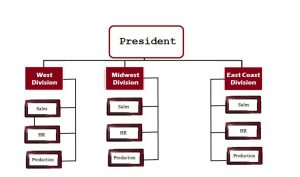6 Organizing
Learning Objectives
The purpose of this chapter is to:
- 1) Introduce the organizing function of management
- 2) Describe the resources needed to achieve organizational goals
- 3) Provide an overview of how structure is needed to implement a gameplan
Organizing
Organizing is the process of assembling and assigning the human, financial, physical, informational, and other resources needed to achieve goals (Bateman & Snell, 2013). At this point in the management process, the planning function has been utilized. The planning should have resulted in both an in-depth analysis of the internal and external environments, as well as a gameplan that flows from that analysis. What’s need now is to put a structure around that gameplan, and to commit the resources necessary to achieve that gameplan. The purpose of the organizing function is to do just that, to make the fruits of the planning process come to life.
Types of Resources
The term resource can be conceptualized as any element or asset that can be used to help the organization or an individual function effectively. Resources are what allow an organization to function. Imagine a firm without any money, no people, no structure, office space, ability to communicate,

or even the authority to make decisions. This type of organization would not have any means to operate, or function in any way. This would analogous to a car without a motor, access to gasoline, a driver, or wheels. Organizations need human, financial, physical, and informational resources to make them go.
Human resources include the personnel that make up the organization’s membership. For a corporation this means the paid employees. For a football team, this is the roster and coaching staff. Some scholars argue that the human element of the organization are the source of competitive advantage (Hagen, Udeh, & Wilkie, 2011). The human resources carry out the gameplan. They make the phone calls. They travel to see clients. They reconcile the inventory. They make the decisions regarding day to day operations. To successfully leverage human resources means first of hiring the right people. Once you have the “right” resources procured, the next task is to train them, and as we will see with the leading function of management, to motivate and inspire them. Organizational culture falls under the management of the human resources of the organization. Culture can either be a source of immense advantage, or a hindrance to operating effectively.
Financial resources equate to the access to capital a firm has. This resource comes from several sources. Primarily, organizations generate income through delivery of a service or good. Revenues from sale of goods allows an organization to grow and increase their access to financial resources. The basic premise here is they take raw materials, put them through a process of some kind, and then deliver that product to society. If society is willing to pay more for the finished product than the raw materials used to make it, the organization has created value. Imagine crude oil sitting under millions of gallons of salt water and tons of earth on the sea floor. Consumers cannot access and process this raw material on their own. Oil companies make their money because they have the access and distribution that consumers do not. When consumer pump the gas into their car, the value created by the organization is realized. A secondary source of financial resources is credit. Most organizations do not operate under a cash-only model because borrowing money from a lender allows for increased return on investment. Organizations also receive resources through donations. Non-profits such

as Operation Underground Railroad receive financial resources from private donations. Their organizational mission is to save children around the world who are victims of human trafficking, and they achieve this by leveraging donations received as their primary source of financial resources. Most non-profit organizations operate under this model since the inception of non-profits. The Roman Catholic Church has implemented this strategy for 2,000 years.
A final method that organizations receive financial resources is through subsidies. The U.S. government for examples, provides grants or loans to a handful of industries such as agriculture, oil, healthcare, automobile, ethanol, housing, and many more. These organizations increase access to financial resources through tax dollars given to them.
Physical resources are the tangible assets that allow an organization to create a product or service. This includes the office space, working space, and the materials the organization uses to create a product. Physical resources are important in manufacturing and service industries alike. Processing raw materials requires equipment, land, and a building in which to operate. Service industries even at the most basic level such as consulting, require a phone, computer, printer, and probably pen and paper.
Informational resources include the knowledge that organization creates and retains regarding its operation and mission. This information includes

copyrights, intellectual property, as well as internal processes that give an organization a competitive advantage. Understanding how to do something is an informational resource. This knowledge can be generated through organizational learning after making major mistakes or successes. It can be a result of in-depth analysis. Financial corporations spend a lot of money on salaries for market analysts so that they can create models to predict what the markets will do. This analysis is a resource the organization can use to pursue its goals. For example, Great Alaska Adventure Lodge, based in Sterling Alaska, provides fishing and hiking expeditions on the Kenai Peninsula. They place value in the knowledge the guides have in delivering safe and entertaining excursions for their clients. A fishing guide who understands water conditions, safe boating practice, and how to attract fish is leveraging informational resources. A hiking guide who knows flora, fauna, and can share history and jokes, is using informational resources. Great Alaska relies on this as a resource and is willing to hire guides who possess this knowledge.
Other organizational resources that warrant mention in a focus on the organizing function of management include the goodwill an organization creates through philanthropy, reputation in how they conduct their business, and the external relationships they have with outside stakeholders that they can leverage to pursue their goals. This includes the rapport they have with customers to complete a sale, a government agent to help navigate a compliance question, or even a supplier who can provide favorable trading terms.
Finally, the concept of authority has been conceptualized as an organizational resource. Authority is defined as the ability to make decisions. This entails all of the decisions to make decisions from the top level of the organization regarding direction to the choices that individuals make regarding how they spend their time throughout the day. A study conducted by Liberman (2014) found that the manner in which an organization manages authority has a meaningful impact on job satisfaction and commitment. Managers are given the rights to make decisions about the operation of the organization. These decisions include who to hire, whether to give someone a raise, how to spend money, which strategy to pursue, which vendor to use, the choice between ethical alternatives, and the hundreds of small decisions throughout the day. Managers can make a choice to given some of that authority to other members of the organization. Empowerment is the act of giving authority to other members of the organization. Empowerment gives employees autonomy over their work, and the freedom to execute the gameplan in the way they think is the most efficient. Delegation, on the other hand, simply refers to giving members of the organization an additional task to complete. It is possible to give someone empowerment without delegation, which means they have more freedom over what they are currently doing. It is possible to give someone delegated tasks without the freedom to make choices around that task. And it is possible to give someone a new task and the freedom to make decisions around that task. For example, a manager needs to throw a reception for an employee who is retiring. She walks over to the administrative assistant who is in charge of receptions and events for the department. She tells the admin, “You have $1,000 to throw a reception. I don’t care where we go, or what we serve. I will leave all of that up to you.” This would be a case of empowerment. Consider another case whereby the manager receives a request from a state agency to file a report on emissions. The manager walks over to his direct report and says, “I need this filed by Wednesday. Go to their website and fill out the form, then submit it.” In this scenario, the manager has delegated the task, but did not provide the empowerment for the employee to do it their own way.
Support your Plan
Organizing flows naturally from the planning process. As we have reviewed, the planning process begins with an internal and external analysis. The purpose of organizing is to put resources towards that plan. It will be the case that some organizational areas need more resources, and others need fewer resources. Let’s put together a scenario to illustrate this. An airplane engine manufacturer decides on a gameplan to increase market share by 10% in the following year. How to allocate organizational resources would be based on internal needs first. In this scenario the salesmen are well trained, have good rapport with clients the major airplane construction firms, and do not need much in terms of their selling abilities. Almost no resources need to be provided here. The lone exception is Frank, the newest team member who needs to be sent to a conference to improve his negotiation skills. The internal analysis conducted during the planning phase identified that the sales process however is slowed by poor delivery in logistics. If an order is placed, customer expect delivery within a week, but a limited distribution staff slows this process. Organizational resources should be committed to hiring an additional distribution scheduler. The external analysis shows that sales are best conducted in person, so the well trained salesman don’t need more training, but they need more budget to get out on the road. In this scenario, the analysis lead to the gameplan as well as identifying where the resources need to be allocated.
The organizing and planning phase of the managerial process can change over time. A weakness in a previous year (lack of training) could be a non-factor in future years. A strength in one year (research and development), could be surpassed by changing market conditions such as competitors catching up. This means that organizational resources need to be reallocated as the gameplan progresses, or the conditions change. Think about the decisions that an trauma surgeon has to make. A patient is brought into the ER with a collapsed lung and a broken ankle. The situation calls for an immediate treatment of the lung because the need is more immediate (asphyxiation). The ankle can wait. Once the patient is stabilized, the ankle can be operated on. Once these two procedures are complete, the trauma surgeon will move on to a more immediate need throughout the hospital to treat trauma. The nurses and resident doctors will tend to the recovery of our patient. As the needs of the situation dictate, so do the organizational resources. Resources include the use of the surgeon, anesthesiologist, and nurses (human resources), his knowledge of how to operate (informational resource), the hospital bed, ward rooms (physical resources), and in the case that the surgeon allows the resident to perform the ankle surgery because its less serious, empowerment (authority resource).

Organizations often have the privilege of long-term planning and matching of organizational resources. The calculated allocation of resources comes as a result of the internal analysis and how the allocation will advance the mission of the organization. The organizing function of management always subordinates itself to the planning function of management. Consider the analogy to a survival situation. A couple goes hiking in the Utah desert and gets lost. They know that the human body has immediate needs that need to be addressed. A human body can last 3 minutes without oxygen, 3 days without sleep, five days without water, 30 days without food, and depending on the conditions, a variable amount of time exposed to the external conditions. Knowing this order of importance will help them make decisions about how to spend their resources. If no one is injured, they do not have to worry about oxygen supply. They find a river and have access to water, but without boiling it expose themselves to external threats of parasites. They choose to spend some of their resources trying to tackle this problem. Once they have water figured out, they focus on finding shelter for the night. Exposure to rain could lead to hypothermia, and exposure to the heat will lead to exhaustion. After constructing a shelter, they begin their gameplan of self-rescue. They have a choice to follow the river to civilization, or wait for rescue. The conditions change as they make progress towards their goal of getting the heck out of there. Organizational resources (energy levels, supplies they had in their backpack, time, survival knowledge) are spent accordingly.

Providing Structure
A final component of the organizing function is to provide structure for the gameplan. This means that managers need to put in place lines of reporting, assign tasks, and to put team members in place to execute the gameplan. Each person has a comparative advantage within the organization which is the value they bring to their job, relative to whatever else they could be doing. Comparative advantage simply means that members of the organization have an opportunity cost for whatever role they are in. If someone is good at accounting, and the organization already has a sufficient number of accountants, that person could best be served to work with the logistics team. If someone is the best sales person on the team, but is the only person who knows how to write computer code, their comparative advantage lies with the programming, and the organization should put them in a role that best serves the organization.
To make sure the team is constructed in a way to increase effectiveness, a manager has to know the strengths of the members of the team, and to put them in the correct position on the team to maximize the comparative advantage of that team member. The law of comparative advantage is the basis for providing the structure to the team. Assigning roles and tasks is a result of understanding the team, and a core component of the organizing function.
This same concept applies to the overall structure of the organization. An organization can provide structure for its operations in a few different ways. A functional structure of the organization groups people together who perform similar tasks. This results in a department style structure whereby all human resource personal work together and report to a manager, all operations personnel work together and report to a manager, the different roles within marketing all work together and report to a manager, and so forth.
Figure 5.1 Functional Organizational Structure

The functional structure comes with a few advantages. Lines of communication are clear to understand and they are simple. If there is an HR problem, you go to the HR manager. If there is a question about the financial statements, you go to accounting. Performance standards are better maintained and easier to identify. If all of the salesmen are working together, there is a relatively quick basis for comparison between them. Additionally, any mistakes and successes can be learned from and benefit all of the members of that functional area of the business. The downside to a functional structure is that it often leads to compartmentalization of decisions. Functional managers fight for the resources their department would garner from a particular course of action. This often means they do not act in the best interest of the overall organization, but rather how it will advance their department.
The divisional structure of the organization is one that groups units within the organization around geographic location, products, or customer types. An organization with a divisional structure will have many units that contain within them all of the functional areas of the business. For example, an organization might have a divisional structure that has a Northwest Division, a West Division, and a Midwest Division. Each of these divisions would have within their groups an HR group, a sales group, an accounting team, and so forth.
Figure 5.2 Divisional Organizational Structure

The divisional structure might choose geography to be the dividing factor, but it might also choose product type. An automobile manufacturer might have divisions for SUV’s, trucks, and passenger vans. In this scenario, each of those divisions would have all of the functional areas of business contained within them. Finally, the choice might be to base the divisions on customer types. Many retailers have wholesale customers and end-use customers that consume their products. They might choose to create divisions based on these two types of customers.
The advantage of this structure is that it allows for each division to better understand the products they are creating as it relates to the consumer preferences. In the geographic breakdown, the manager of the Northwest Division would have an in-depth understanding of the logistics, challenges, and market conditions of his region. This allows for efficiency in delivery of goods, and customization of the products brought to that market. What works in one region might not work for another, and this flexibility allows for better focus on the market. The downside to this structure is that there could be duplication of resources. An accounting team in one region might be sufficient to meet the needs of that group, but could have excess capacity that would better be used in another region. The divisional structure does not easily allow for that capacity to be shared with other divisions. In the same manner that a functional structure leads to managers fighting for their own groups, division structure can lead to that same isolation of groups. Managers will make decisions often times in the best interest of their division, which may sacrifice the best interests of the overall organization. We will see later in the leading function how this might be overcome.
Finally, organizations might choose to utilize a matrix structure, which creates a dual structure utilizing both a divisional and functional setup. The matrix structure uses a cross functional design to leverage the economies of scale that the functional structure offers, as well as the customization that a divisional structure affords. A matrix structure is often used in organizations where projects require the expertise of various employees. Each project team will have experts from the relevant parts of the organization. Once the project is complete, the team is disbanded and reformed around a new project. Consider its use in an engineering firm where they contract for construction of a bridge, a road, or a building. Consider its use in firms conducting due diligence on an acquisition or merger.
Figure 5.3 Matrix Organizational Structure

The advantage of the matrix structure is that it allows for better informed decisions and more creative solutions because the wide array of expertise each team has access to. Decision making for each project is often pushed down to the cross-functional team level, which allows upper management to focus on organizational direction and strategy. The downside to this structure is that employees can have a dual reporting relationship to the project leader, as well as their functional manager. This can create conflict between the two managers, and confusing for the employee.
Critical Thinking Questions
Time was not listed as a resource in this chapter. Should it be, or is this simply a constraint that managers operate under? Make your case.
What role does the organizing function play in supporting the planning function?
Empowerment means letting others make decisions. Why are many managers hesitant to empower their subordinates?
How to Answer the Critical Thinking Questions
For each of these answers you should provide three elements.
- General Answer. Give a general response to what the question is asking, or make your argument to what the question is asking.
- Outside Resource. Provide a quotation from a source outside of this textbook. This can be an academic article, news story, or popular press. This should be something that supports your argument. Use the sandwich technique explained below and cite your source in APA in text and then a list of full text citations at the end of the homework assignment of all three sources used.
- Personal Story. Provide a personal story that illustrates the point as well. This should be a personal experience you had, and not a hypothetical. Talk about a time from your personal, professional, family, or school life. Use the sandwich technique for this as well, which is explained below.
Use the sandwich technique:
For the outside resource and the personal story you should use the sandwich technique. Good writing is not just about how to include these materials, but about how to make them flow into what you are saying and really support your argument. The sandwich technique allows us to do that. It goes like this:

Step 1: Provide a sentence that sets up your outside resource by answering who, what, when, or where this source is referring to.
Step 2: Provide the quoted material or story.
Step 3: Tell the reader why this is relevant to the argument you are making.
Chapter References
Bateman, T., & Snell, S. (2013). M: Management (3rd ed). McGraw Hill / Irwin: New York,
NY
Hagen, A., Udeh, I., & Wilkie, M. (2011). The Way That Companies Should Manage Their Human Resources As Their Most Important Asset: Empirical Investigation. Journal of Business & Economics Research (JBER), 1(1), Journal of Business & Economics Research (JBER), 02/11/2011, Vol.1(1).
Liberman, L. (2014). The impact of a Paternalistic Style of Management and Delegation of Authority on Job Satisfaction and Organizational Commitment in Chile and the US. Innovar, 24(53), 187-196.

